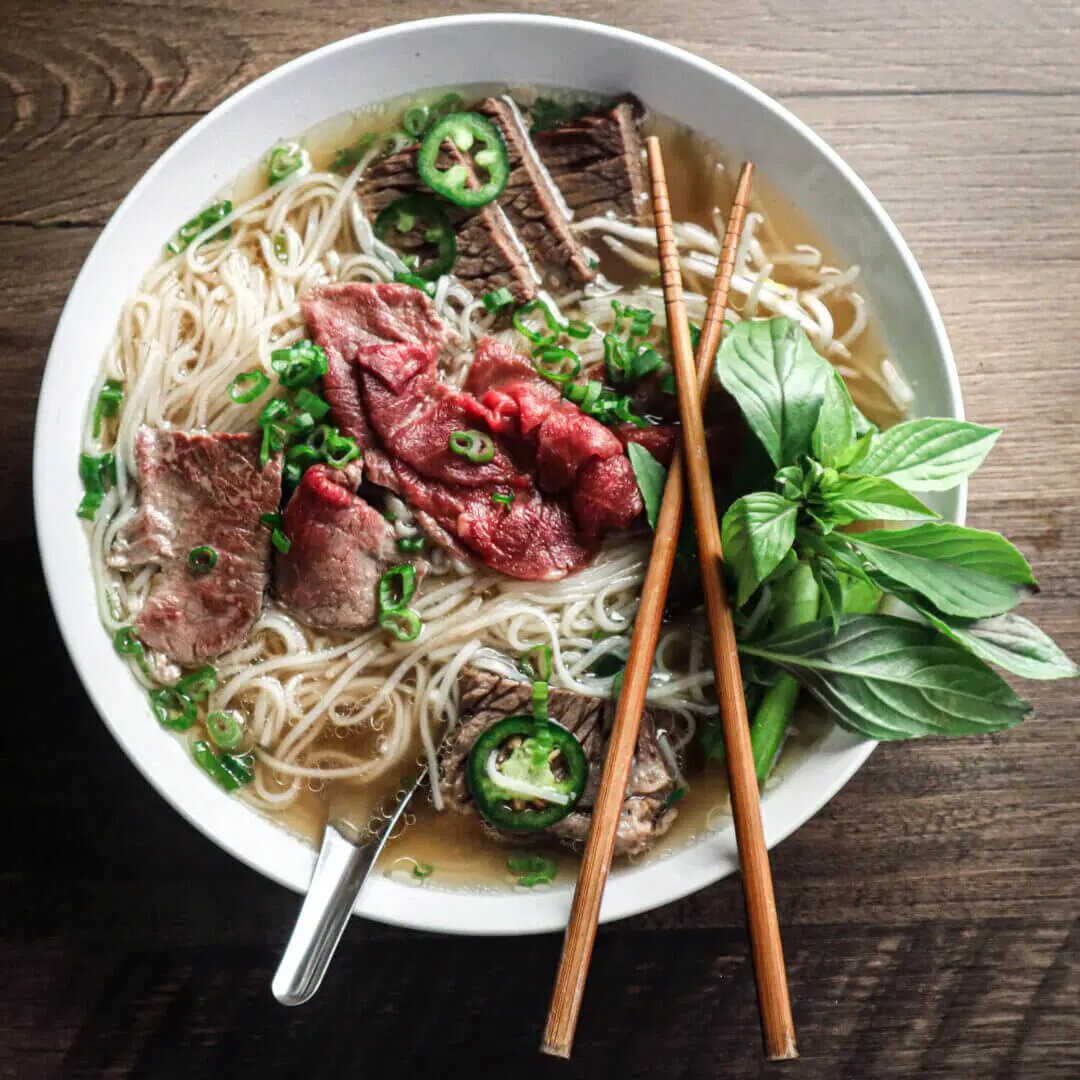Phở Tái Bò (Beef Pho)
I’m Tu David Phu, Top Chef Alumnus, Vietnamese-American, and SF Chronicle Rising Star Chef from Oakland. I’ve cut my culinary teeth in the kitchens of some of the nation’s top restaurants. But it was my “memory of taste” that pulled me back to my Vietnamese roots: the practices, ingredients, techniques, and flavors of Vietnamese cuisines. These recipes are my stories. And I hope it will inspire you (as much as it inspired me) to discover and eat thoughtfully.
Check out my recipe using the Mekong Delta Spice Collection.
Ingredients
Broth
- 2 lbs. beef chuck
- 1 each yellow onion
- 1 each garlic head
- 2 oz. Hawaiian ginger, fresh and unpeeled
- 5 pods Spice Tribe Sun Dried Star Anise
- 1 stick Spice Tribe True Ceylon Cinnamon Stick
- ½ tsp. Spice Tribe Aegean Fennel Seeds
- ¼ tsp. Spice Tribe Highland Cloves
- 2 tbsp. Organic sugar
- 2 tbsp. Kosher salt
- 4 tbsp. Son Fish Sauce
- Fill to cover, Water [do not overfill beyond max capacity, reference Instapot manual]
- 2 quarts Beef Bone Broth
Pho Noodles
- 14 oz. Pack Three Ladies Dried Pho Noodles
Garnishes
- 12 oz. Top Round Bush-Gyu “Samurai” Wagyu
- 16 oz. Bean Sprouts 2 bunches Scallions, sliced
- ½ each Yellow Onion, sliced
- 1 each Jalapeño, sliced
- 1 bunch Thai basil
- As needed, Hoisin & Sriracha
- Tiger Satế optional [this is my favorite pho condiment]
Directions
Prepare the Beef Chuck
- Brine Beef Chuck to clean and remove any impurities that seep into the pho broth.
- In a large pot, fill it with 2 quarts of cold water.
- Add 2 tablespoons of kosher salt, mix until salt is dissolved.
- Submerge the beef for 15-20 minutes.
- Drain water and rinse beef under cold water, until water runs clear.
Make The Broth
- Roast aromatics.
- Set oven on broil (low) preheat for 5 minutes or fire roast on gas stove].
- Slice ginger into 1” chunks, do not peel.
- Slice onion into 1 “ chunks do not peel.
- Break apart garlic cloves, do not peel.
- Place all aromatics in the oven to broil for 10 minutes.
- Place all roasted aromatics into Instapot.
- Toast spices.
- In a small saucepan, place in the cinnamon stick, star anise, clove, and fennel seeds.
- Heat saucepan over low heat for 3-4 minutes, continually moving the pan to prevent the spices from burning.
- Add spices into the Instapot with Beef chuck.
- Fill the Instapot with 2 quarts of bone broth.
Direction:
Season the Instapot.
- 1 tsp Kosher Salt.
- 4 tbsp. Son Fish Sauce
- Fill the Instapot with water up to max line
- Set Instapot on “High Pressure” for 1 hour.
- After the Instapot timer goes off, release the pressure reference manual].
- Remove Beef Chuck from broth to cool at ambient temperature.
- Strain the broth through a fine mesh strainer.
- Once the pot comes to a simmer, bring the heat down to a low-medium.
- While the broth is cooking, it’s a good time to prepare the noodles, and also the herbs for the table so you have everything ready.
- Continue to skim the broth to remove impurities.
- Continue to simmer the broth for an additional 30 minutes.
- Turn the heat to low, to keep the soup hot.
Cook the Noodles
- Soak the dried rice noodles in hot tap water for 10 minutes. They will soften just a bit, and become more opaque. Drain the noodles.
- Simultaneously, bring a separate pot of water to a boil.
- Bring 2 quarts of water to boil.
- Add noodles, stir occasionally to prevent sticking and burning.
- Cook until the noodles are done (2-3 minutes).
- Once the noodles are done, drain the noodles into a food colander and rinse them thoroughly with cold water until the water runs clear.
Recipe Note
PHO HISTORY
[Pre-Occupation]
Pho was originally made with water buffalo. And it wasn’t as popular at the time. It was a regional dish found in Northern Vietnamese provinces. It wasn’t until the 19th century [French Occupation] that Water Buffalo in Pho was replaced with the European cow, specifically in Hanoi.
[1900-1950s]
There are many contributing factors & theories. However, there was one main fact that gave birth to Beef Pho; Hanoi was the capital of French-Indochina [compiled nations of Vietnam, Laos, Cambodia, & the Chinese territory of Guangzhuowan]. Thus, translating a strong presence of French colonists. The demand from French palates brought the European cow.
Naturally, the European cow (as an ingredient) would find its way to Hanoi’s food scene to be utilized as an essential ingredient; beef found its way to be the permanent substitute for water buffalo in pho. Considering these historical contexts & cultural intersections, going into the 20th century, Pho would be an iconic staple in street food in Hanoi. And its popularity was contagious. In the next 50 years, Pho would go from a local Hanoi favorite to a national dish.
[1950s-1975]
In the latter half of the 20th century, food rationing was imposed on the citizens of Vietnam, in particular rice. And left no room for other ingredients (beef) as it was considered a luxury item. This “shift in policy” immediately reflected in the way people cook. Recipes were adapted. And Vietnam’s iconic Beef Pho evolved to Chicken Pho.
[1980’s]
The International Vietnamese Diaspora community is a generation without. Their generation [birth years: 1950s-1980s] experience severe hunger. Thus, translating into their special relationship with food. In their new communities, they would attempt to assimilate. However, their memory taste of Pho remained. And it was in these expat Vietnamese communities that Beef Pho, once again, had its uprising.



